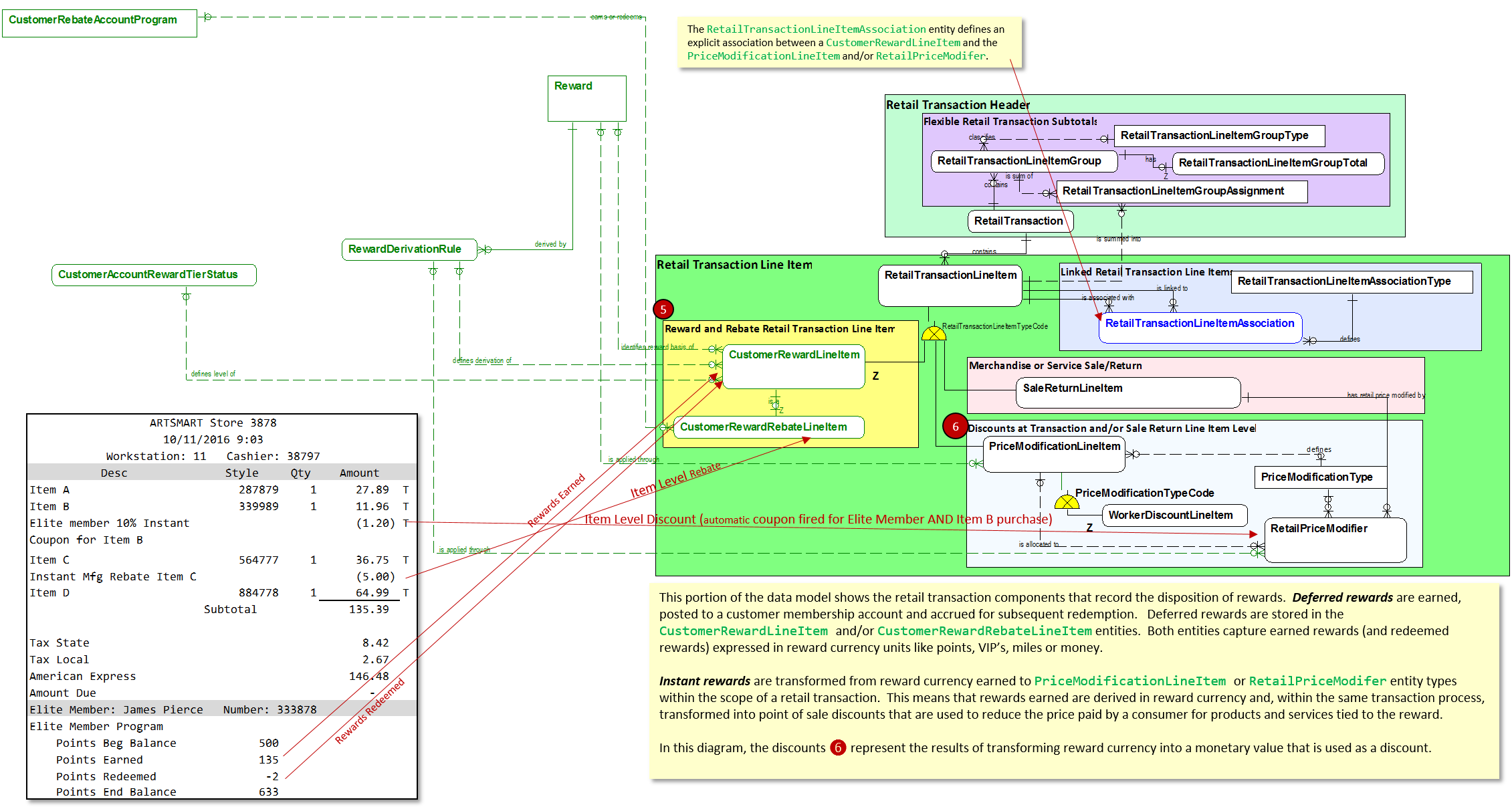Reward accounting and disposition is typically incorporated into retail transaction and order processing applications. In ARTS, reward currency (i.e., points, VIP's, miles, etc.) earned is recorded in the CustomerRewardLineItem entity type. Once earned, a reward may be accrued in a customer account for future redemption or it may be redeemed in the current transaction. The former reward disposition is a deferred reward. The latter reward disposition is an instant reward. It is also possible for a customer to consume previously accrued reward currency in the current transaction as discounts or some other debit offset to pay for purchases. The CustomerRewardLineItem entity provides a place for capturing reward earn actions and reward redeem actions.
Within the scope of a RetailTransaction, reward accounting (earn and burn just discussed) is handled by CustomerRewardLineItem entity. For redeemed rewards that are transformed into discounts, retail transactions will include PriceModificationLineitems and/or RetailPriceModifier entities to represent the monetary value applied to reduce the price a customer pays to settle the transaction. From a procedural point of view, an application will take in a reward redemption as a reduction of reward currency value, convert that value into a monetary amount and generate a PriceModificationLineItem (for a transaction level discount) or a RetailPriceModifier for a line item level discount. While the line item entity types related to reward accounting are separate and distinct from the line item entity types used to represent discounts, they may be associated using the RetailTransactionLineItemAssociation entity type. The RetailTransactionLineItemAssociation entity is a general purpose join structure that links any two different retail transaction line items together. For reward redemption purposes, the entity is used to establish a link between a reward redemption CustomerRewardLineItem and the PriceModification and/or RetailPriceModifer used to apply the discount derived from the reward.
The diagram show here illustrates a sales receipt that includes a rewards section at the bottom of the receipt. In this example, there are two rewards. The first is an Elite Club member automatic coupon for 10% off of the targeted item. This is an example of an instant reward that is automatically applied based on the customer's being an Elite Club member and their purchasing Item B (two eligibility conditions met by the second line item.
The second is an instant manufacturer rebate with a value of $5.00 that is recorded as a CustomerRewardRebateLineItem. Unlike the 10% coupon, this reward is NOT a discount. It is a kind of bill back receivable in which the manufacturer will reimburse the retailer for the $5.00 it applies against the customer's payment due amount for the transaction. The different accounting treatment for rebates is one of the primary reasons why they are modeled separately from rewards. Additionally, while rewards may be denominated in a variety of different reward currencies, rebates are always denominated in monetary units (as modeled in ARTS).
Figure 38 - Reward Line Items and Price Modifier Line Items

In this diagram and example, redeemed rewards are transformed into discounts. It is also possible to link reward redemption actions to other kinds of retail transaction line items like StoredValueFundsSaleLineItem, PaymentOnAccountLineItem (as a credit memo), etc. Unlike the discounts illustrated in the preceding diagram which are taken immediately, these line items represent deferred benefits that may be used to offset future purchases. These deferred reward redemptions may be linked to the CustomerRewardLineItem using the RetailTransactionLineItemAssociation as discussed in the discount example.